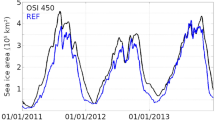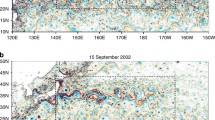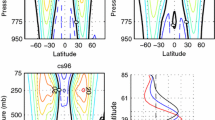Abstract
We describe the initial bias of the climate simulated by a coupled ocean-atmosphere model. The atmospheric component is a state-of-the-art atmospheric general circulation model, whereas the ocean component is limited to the upper ocean and includes a mixed layer whose depth is computed by the model. As the full ocean general circulation is not computed by the model, the heat transport within the ocean is prescribed. When modifying the prescribed heat transport we also affect the initial drift of the model. We analyze here one of the experiments where this drift is very strong, in order to study the key processes relating the changes in the ocean transport and the evolution of the model's climate. In this simulation, the ocean surface temperature cools by 1.5°C in 20 y. We can distinguish two different phases. During the first period of 5 y, the sea surface temperatures become cooler, particularly in the intertropical area, but the outgoing longwave radiation at the top-of-the-atmosphere increases very quickly, in particular at the end of the period. An off-line version of the model radiative code enables us to decompose this behaviour into different contributions (cloudiness, specific humidity, air and surface temperatures, surface albedo). This partitioning shows that the longwave radiation evolution is due to a decrease of high level cirrus clouds in the intertropical troposphere. The decrease of the cloud cover also leads to a decrease of the planetary albedo and therefore an increase of the net short wave radiation absorbed by the system. But the dominant factor is the strong destabilization by the longwave cooling, which is able to throw the system out of equilibrium. During the remaining of the simulation (second phase), the cooling induced by the destabilization at the top-of-the-atmosphere is transmitted to the surface by various processes of the climate system. Hence, we show that small variations of ocean heat transport can force the model from a stable to an unstable state via atmospheric processes which arise wen the tropics are cooling. Even if possibly overestimated by our GCM, this mechanism may be pertinent to the maintenance of present climatic conditions in the tropics. The simplifications inherent in our model's design allow us to investigate the mechanism in some detail.
Similar content being viewed by others
Author information
Authors and Affiliations
Additional information
Received: 18 February 1998 / Accepted: 22 April 1999
Rights and permissions
About this article
Cite this article
Cohen-Solal, E., Le Treut, H. Unstable behaviour of an upper ocean-atmosphere coupled model: role of atmospheric radiative processes and oceanic heat transport. Climate Dynamics 15, 895–908 (1999). https://doi.org/10.1007/s003820050320
Issue Date:
DOI: https://doi.org/10.1007/s003820050320




